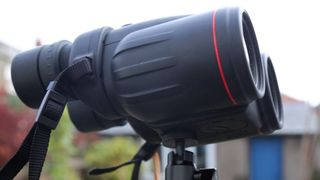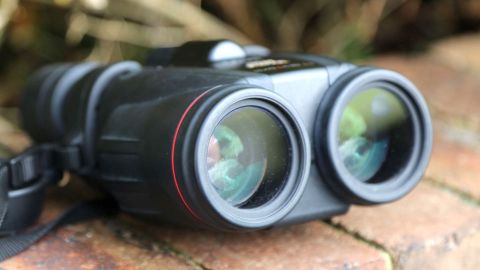Space Verdict
The Canon 10x42L IS WP binoculars are pricey but almost perfect for hand-held astronomy. In a market saturated with low-priced astronomy-centric binoculars, some clear, sharp and high-resolution optics and image stabilisation wizardry make the waterproof Canon 10x42L IS WP binoculars expensive, but worth it.
Pros
- +
Optical Image Stabilizer
- +
Excellent quality optics
- +
Rugged outdoorsy design
- +
Generous eye relief
- +
Built-in tripod thread
Cons
- -
Heavy
- -
Loose lens caps
- -
IS requires (lots of) AAA batteries
- -
Very expensive
Why you can trust Space.com
There’s something very special about the Canon 10x42L IS WP that makes them among the finest astronomy binoculars available. It’s hard to beat a good pair of binoculars for astronomy, but there’s an inconvenient truth that makes even the best binoculars play second-fiddle to the best telescopes in the public’s imagination. Binoculars of the kind that can give excellent views of the night sky are rather large and heavy. That makes them difficult to hold still. The result is ‘wiggly’ stars that appear to jump, loop and dance via even the finest quality optics.
Not with the Canon 10x42L IS WP binoculars. The only member of Canon’s L Series of binoculars (which uses the same L glass found in Canon’s finest camera lenses), not only do they come equipped with astronomy-centric glass, but they also boast Canon’s Optical Image Stabilization (IS) technology.
Magnification: 10x
Objective lens diameter: 42mm
Angular field of view: 6.5 degrees
Eye relief: 0.57-inch
Weight: 39.2 oz
Though not exactly exclusive to Canon, the IS system used here is not widely used. That’s partly because it’s so expensive, though few who have had the good fortune to try this electronic system consisting of motion sensors and a ‘vari-angle prism’ will say it’s not worth the outlay.
It works like a dream; you press a button and the 'shake' disappears. For anyone who’s struggled with keeping binoculars steady enough for properly immersive stargazing, the Canon 10x42L IS WP are the answer.
Not only do they come at a price but there are a few drawbacks. The IS system takes significant battery power and the package includes some disappointing lens caps. However, as a pair of technologically advanced binoculars for astronomy, the Canon 10x42L IS WP are hard to beat.
There are a lot of other sizes in Canon’s range of image-stabilized (IS) all-weather (AW) binoculars including 18x50 IS AW and 15x50 IS AW. With higher magnifications (3.7º and 4.5º, respectively) and larger objective lenses, both are good alternatives for astronomy. However, not only are they significantly heavier than the Canon 10x42L IS WP, they also lack the premium L-series glass that transmits more light for a brighter image.
Canon 10x42L IS WP binoculars: Design
- Porro II prism
- Vari-angle prism with 0.8° correction angle
- Waterproof design

The Canon 10x42L IS WP are designed to withstand much more than the clear sky amateur astronomers play under. In fact, their waterproof design makes them as suited to extreme weather conditions as to astronomy. Either way, their rubber-covered 5.4 x 6.9 x 3.4-inch size and 39.2 oz weight make them sturdy to the point of being too heavy to hold steady. Cue Canon’s Optical Image Stabilizer (IS) technology, a system of electronics that effortlessly takes the shakes out of stargazing.
Carrying case
Objective lens caps
Double eyepiece cover
Neck strap
In keeping with many advanced astronomy-centric binoculars the Canon 10x42L IS WP boast a Porro prism design, though it’s their vari-angle abilities that are particularly advanced. It uses a system of gyroscope motion sensors to detect how much your arms are moving and how much wobble they’re introducing to the image you see. Some actuators around the lenses then cancel out that wobble to a correction angle of 0.8°. What happens is that the vari-angle prism moves to correct the refraction angle of incoming light. It’s clever stuff and works in an instant; you just touch the push button switch on the top of the right-hand side’s barrel.
However, the optical quality goes way beyond mere electronics. The Canon 10x42L IS WP features ultra-low dispersion (UD) lens elements, which make single points of light clearer – an obvious advantage when stargazing – and give accurate colors. The objective lenses, meanwhile, have Canon’s multi-layered anti-reflective lens coating called ‘Super Spectra’ to avoid ghosting and lens flare, and improve color reproduction.

We also think that the 6.5 degrees field of view makes the Canon 10x42L IS WP ideal for general astronomy; anything with more magnification is verging on deep sky-astronomy – and if that’s your aim then you should go for something like the Celestron SkyMaster 25x100 binoculars and put them on a tripod. Of course, the Canon 10x42L IS WP are designed to not need a tripod, but just in case you want to easily share observations with others they do include a standard 1/4-inch tripod thread on the undercarriage.

Where the Canon 10x42L IS WP as a package generally disappoints is with the extra gear in the box. The exception is a neck strap, which uses neoprene and is comfortable, adjustable yet fairly short, as it should be. The eyepieces have a joint cover that protects both simultaneously, though it’s fairly loose. Thankfully it’s got a loop that can be attached to the neck strap so it doesn’t get lost. What we found most disappointing was the lens caps for the objective lenses. Provided as a one-piece and also with a loop to attach to the strap, this slim rubber one-piece does a poor job of staying in place. The Canon 10x42L IS WP’s saving grace is that they have a 52mm filter thread so can easily and cheaply be upgraded to Canon LC-52 Center Pinch lens caps that are widely available for Canon’s camera lenses. You might also want to think about upgrading the carrying case, which is very basic and flimsy. At this high price, these oversights are a shame.
Canon 10x42L IS WP binoculars: Performance
- Bright and colorful images
- Detail and clarity when using IS
- 16mm eye relief

Though aimed as much at maritime users and bird-watchers, the Canon 10x42L IS WP really comes into its own for stargazing. With an exit pupil diameter of 4.2mm and those 42mm objective lenses, they perform excellently in low light, providing a bright high-resolution view all night long. During the day they also offer close focus of 8.2 ft, which is useful when bird-watching, though they can be slightly slow to focus.
That’s partly down to the ponderous focusing ring that’s set on the bridge of these binoculars. When used in collaboration with the usual diopter ring around the right-hand eyepiece the Canon 10x42L IS WP proved easy to calibrate.

The IS system is so good it’s addictive, though it does have its limits. Its actuators can cancel-out shake to an angle of 0.8°, so if you’re wildly moving the Canon 10x42L IS WP then, of course, the stars will still wobble incessantly. So although it’s capable of unrivaled detail and clarity, a slight drawback can be that even when you’re as still as possible and IS is engaged there sometimes exists a tiny amount of softness in the stabilized image. It’s most easily kept to a minimum almost by pretending that the Canon 10x42L IS WP don’t have that ‘magical’ IS mode at all. The usual techniques – bringing in your elbows into your core and leaning against a wall, or sitting down – while using binoculars should be employed to ensure the Canon 10x42L IS WP is correcting as little as possible. The result of doing that is incredible sharpness. Seriously, you’ll be gazing up at the Moon for hours … ditto the Pleiades and other star clusters, the Orion Nebula and everything else in the night sky. The UD lens elements and Super Spectra lens coatings keep images bright while the ‘L’ glass means low dispersion, so no chromatic aberration (purple fringing around bright objects).
The wondrous effect of the IS system is that you’re going to want to use the Canon 10x42L IS WP for longer than you would most astronomy binoculars for the very reason that you get an addictive super-steady view. At 39.2 oz that’s not always easy in practice because your neck will start to ache, though something else that does make the Canon 10x42L IS WP comfortable to use for long periods is its generous eye relief.

The binoculars have got pull-out eyecups that gently twist out to 16mm. As well as making the Canon 10x42L IS WP suitable for anyone who wears glasses, those twist-out eyecups also help block-out ambient light sources and encourage a more immersive view.
There is a drawback. After you depress the IS button, that mode kicks in and a red LED lights up, but it disengages after about a minute to save power. That’s useful because the IS circuitry uses a lot of battery power. Canon quotes around 2.5 hours at temperatures over 25°C and just 10 minutes at -10°C. In cold conditions, it’s more like the latter, which means that you have to use the IS sparingly, but you also need to carry with you a spare pack (or two) of AAA batteries. It’s wise to take along a coin, too, to open the battery compartment cover.
Should you buy the Canon 10x42L IS WP binoculars?
The Canon 10x42L IS WP are not perfect, but they’re as close as you’ll get for hand-held astronomy. They eat up AAA batteries in cold weather, the included accessories are generally poor – save for the excellent neck strap – and they are incredibly expensive. The reasons for the latter is, of course, the Canon 10x42L IS WP’s advanced optics and the addictive electronic wizardry that is IS circuitry. Correcting for wobble and judder that comes for the Canon 10x42L IS WP being hand-held and therefore ridding images of wiggly stars, it’s the perfect solution for anyone who wants a long, lingering look at the Moon, stars, open clusters and nebulae.
Easy to travel with and as outdoorsy a pair of binoculars as you’ll find, the weatherproof and wonderful Canon 10x42L IS WP are capable of revolutionizing how you do astronomy. Who needs a telescope?

If this product isn't for you
The Canon 10x42L IS WP's high price means more affordable all-rounders like the Celestron TrailSeeker 8x42 are worth considering. Among the best roof prism binoculars you can buy right now, they have similar basic specifications yet also add a nitrogen-purged, waterproof design and 17mm of eye relief. Another similar option is the Opticron Adventurer II WP 10x50 roof prism binoculars, which use lower quality glass. If you’re after high-end astronomy binoculars that are close to a telescope as possible go straight to the Celestron SkyMaster 25x100 binoculars, which will give you close-ups of deep-sky objects yet lack Canon’s IS, so they do need to be mounted on a tripod.
Join our Space Forums to keep talking space on the latest missions, night sky and more! And if you have a news tip, correction or comment, let us know at: community@space.com.

Jamie is an experienced science, technology and travel journalist and stargazer who writes about exploring the night sky, solar and lunar eclipses, moon-gazing, astro-travel, astronomy and space exploration. He is the editor of WhenIsTheNextEclipse.com and author of A Stargazing Program For Beginners, and is a senior contributor at Forbes. His special skill is turning tech-babble into plain English.

